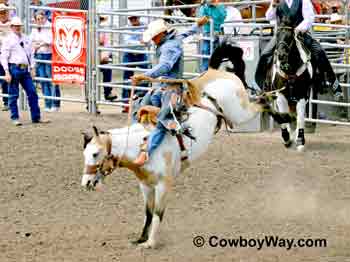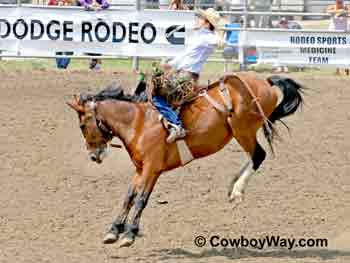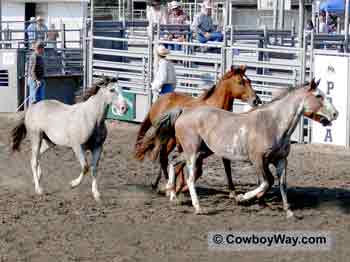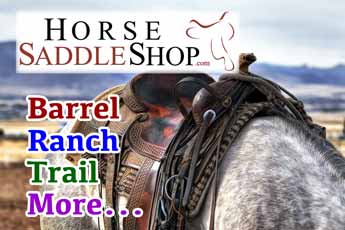Is Rodeo Bronc Riding Cruel?
The romantic image of the wild horse, untamed and unwilling to bend his spirit to the whim of humans, is something many Americans hold dear. When this image is superimposed over the feral horses still running loose in our county, we consider these horses noble, privileged, and majestic.
Why then, when this kind of horse wins a one in a thousand chance to live his life untamed and bucks in a rodeo, do some of us consider it cruel?
Today’s modern saddle horses have been bred for centuries to be gentle and trainable. It is a rare occasion when an individual will come along with a strong, natural desire to buck. By bucking I don’t mean the brief, natural reaction some horses will have when first introduced to saddle and rider, or the playful or "cold-backed" tendencies some horses have all their lives.

By bucking I mean the strong, undeniable urge to buck wildly and wholeheartedly. Why some horses are born like this, no one knows, but close observers understand it is unassociated with pain, fear, or any other negative stimuli.
A rodeo bronc bucks because it is an extremely rare individual that wants to. A bronc does not buck because it is in pain or because it is afraid. Following are a few facts regarding rodeo bronc riding and two sometimes misunderstood pieces of equipment: flank straps and spurs.

Flank Straps
The outside of the flank strap is made of leather. The inside is lined with sheepskin or neoprene. Rodeo rules specify the flank strap must be lined with enough sheepskin to cover the belly of the horse and both flanks, and that no sharp or cutting edges of any kind be present. These rules are consistent with what animal behaviorists have taught us regarding animals such as the horse: his first reaction to pain or danger stimuli is to flee. A horse who is afraid or in pain won’t buck, he will try to run away.
A horse has 18 ribs, and the kidneys are protected by the ribs. It is physically impossible to damage these major organs with the flank strap as the strap is nowhere near them. It is also physically impossible to cover the genitals - of a male or female horse - with the flank strap.
So if these horses really want to buck on their own, why use a flank strap? The flank strap alters the bucking action of the horse by encouraging him to kick out straighter and higher with his hind legs, thus making himself harder to ride. The flank stacks the odds in favor of the horse. It cannot make him buck.
In fact, the flank strap is so acceptable to the bronc that he can become "broke" to it very easily. This is why the pickup men move in so quickly at the end of the bronc ride. They want to get the flank off the bronc as quickly as possible so he won’t become accustomed to it.
This is the same reason the flank strap is hung very loosely and very far forward on the bronc waiting his turn in the chute. It is not "pulled" until the very last second before the bronc takes his first leap into the arena. The flank strap is never tied, and loosens with each buck the horse takes. It is also equipped with a quick release handle to facilitate it’s fast removal. All these measures are taken to prevent the bronc from becoming "broke" to the fleece or neoprene lined flank.
What happens when a horse with no natural inclination to buck is flanked? It may take a couple of leaps - not bucks - then simply run to the end of the arena. In fact, this is an all-too common sight for the stock contractor. Since rodeo broncs are extremely hard to find, the contractor is always willing to try a reported bucker. Watching a "mankiller" gallop happily to the end of the arena - bronc rider on board and flank strap in place - is a frustrating sight witnessed all too often by the stock contractor.
Spurs
Putting the odds in favor of the horse is also why bronc riders are required to spur the horse. It is much harder for them to ride the horse when they do so. Try this: sit down in a straight-backed kitchen chair with your feet flat on the floor. Have someone shake the back of the chair. Now do it again, only this time hold your feet up and out in front of you in the same position a bronc rider would if he were trying to spur the horse on the shoulders. When the chair is shaken this time it is much easier to get "bucked off".
Bronc riding spurs are required to be blunt and free spinning so as not to injure the horse in any manner. (Bull riding spurs may be loosely locked for use on the looser hided bulls, but they must still be blunt.) Any bronc or bull rider who attempts to use non-regulation spurs is disqualified.

Where Do Broncs Come From?
A large percentage of broncs are the result of specialized breeding programs designed to produce horses that want to buck. However, some broncs come from the general riding horse population. Since horses have been bred for centuries to be gentle and trainable, a horse that was intended to be a riding horse that instead has a strong natural desire to buck is unusual. When a horse that was intended to be ridden wants to buck instead, he usually represents a great deal of heartache for the owner, who is reluctant to give up on the dreams he holds for the animal - or the financial investment he has in him.
If the horse is lucky, and if he is exceptionally good at bucking, he may find his way to a rodeo string. There he will be allowed to buck like he instinctively wants to.
If the horse is not so lucky, and the people in charge of his care do not understand that some rare individuals can never be broken, the horse may be subjected to extreme treatment. Methods sometimes employed to break this kind of horse include starvation and beating. Devices designed to block off a horses’ air, or to cut or tear him somewhere in the face or mouth may be used in an attempt to make it too painful for him to lower his head and buck efficiently. The true bronc, however, will return to bucking immediately upon the removal of the pain stimuli.
It is highly ironic that when a horse treated in this manner finds a home as a rodeo bronc, where he is not only allowed to buck with no punishment but where he is also highly prized and well cared for, that the misinformed would have him "rescued".
Rodeo Livestock Injuries
The Professional Rodeo Cowboys Association (PRCA) formed rules and guidelines for proper and humane treatment of livestock in 1947, a full 7 years before the founding of the Humane Society of the United States.
One Last Thing.....
"Girding" is a very old and time-honored method of restraining a large animal by putting a girding device (such as a rope) in the flank area and pulling it tight. This makes the animal unwilling to move and is an effective way of restraining him for medical treatment. To pull a flank strap too tightly on a rodeo animal would cause the animal to refuse to move, let alone buck.
"Is Bronc Riding Cruel?" By Emma Carpenter
For More Humane Facts On Rodeo Contact:
- The Professional Rodeo Cowboys Association (719) 593-8840 www.prorodeo.com
- The International Professional Rodeo Association (405) 235-6540 www.iprarodeo.com
- The National Animal Interest Alliance. The NAIA is a tireless fighter of animal rights extremist organizations.
Cruelty To Animals - Reporting Abuse
Abuse of any animal should not be tolerated. Report any suspected abuse immediately to your local humane organization. If there is no humane organization in your area, contact your local sheriff’s department or similar law enforcement agency.
This article was originally published in the
July 11, 1997 newsletter of Dr. Doug Nielsen, DVM, Andover, KS.
Reprinted here with his knowledge and consent. We're sad to say
that Dr. Nielsen passed away in June, 2018.
